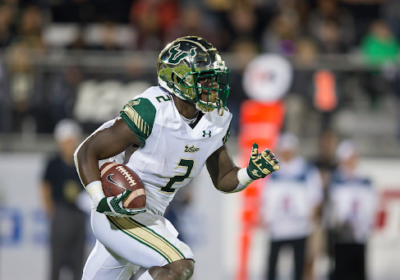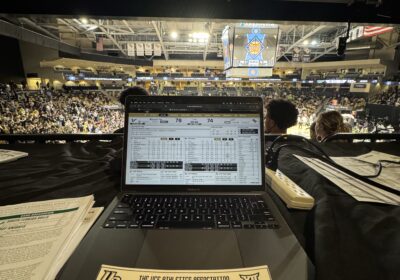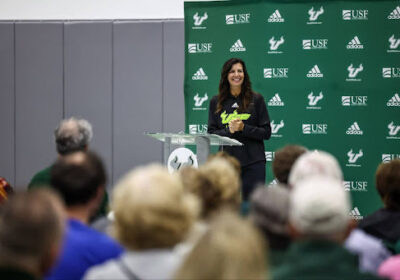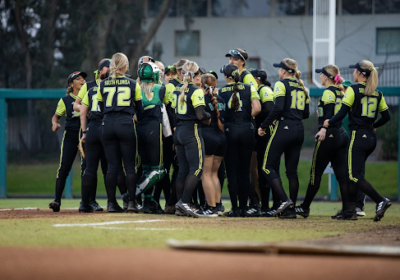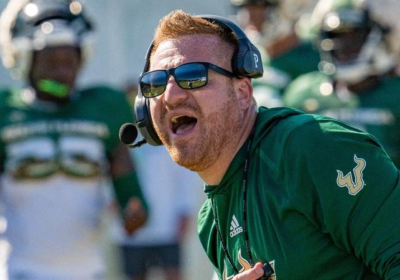Rise and shine: The awakening of USF’s sleeping giant

Junior Rigel Fernandes left his family in Dubai to pursue his golf career. Now his team in making its second consecutive national championship appearance. SPECIAL TO THE ORACLE/GOUSFBULLS.COM
It was once just a pile of dirt.
A barely visible patch off North 46th Street — just north of the USF campus — surrounded by a sub-par golf course, and a small practice green, it was certainly nothing to call its own.
That’s what Chris Malloy inherited in 2010 when he left Florida State to take the coaching job with USF men’s golf. The school was ranked in the low 200’s with no clubhouse and was the school’s only athletics program without a proper locker room.
Malloy sat and looked at an empty trophy case filled with piles of dust and a vision — of USF returning to national relevance, where it hadn’t been since the 70’s.
Six years later, a handful of athletes and two coaches have put USF in position to make that dream a reality as the Bulls embark on its second quest toward college golf immortality.
But before that could transpire, Malloy had to plant the seed.
“I wouldn’t let recruits visit campus until I got a chance to figure out what the hell I was going to sell them on. I knew what I saw when I came on the visit and the facility was God-awful. So I was like, ‘I can’t sell them on the facility.’ It was so bad.”
Upon taking the job in July with next to nothing to dazzle potential players, recruiting was a struggle.
This forced Malloy to sift through golfers that had been overlooked by other schools. For Malloy and the staff, it wasn’t ideal, but it was all they had.
“The best advice I got from one of my old bosses at Florida State was: ‘You don’t have to go out and recruit the All-American, or the No. 1 kid in the country,’” Malloy recalled. “’To build a program, you just have to get guys in there that are better than what you have.’
“I knew that we were going to be good, but I didn’t know how.”
Among the pile of passed-over players were Trey Valentine, Branden Collins and Richard James.
Collins had one good season and before fizzling out, but Valentine and James would become the first pillars of what Malloy was attempting to build from the ground up.
“Well, nobody wanted them,” Malloy said. “They were guys that were just sitting there and were dying for a place to go and we were lucky that Trey Valentine turned out to be a pretty darn good player and he helped build (the program).”
Then came Chase Koepka, brother of PGA Tour member Brooks Koepka who played under Malloy at FSU — that was his first pitch.
Malloy soon began to fill Koepka’s head with a picture of the future with Koepka standing at the forefront as what Malloy painted as potentially the best golfer to ever pass through USF — a picture Koepka is on his way to living up to after what could be his third straight All-American season.
He told Koepka, “You can go there and be a guy, or you can come here and be ‘the’ guy.”
It didn’t take much convincing.
“A lot of it was the ability for me to have a chance to play right away … because I just felt like in order for me to get better, I had to play right away,” Koepka said.
He and Malloy shared the vision and goal: build the program and one day bring a title to USF.
“The belief I saw in this program, I knew it wasn’t going to be overnight that we were going to go from below average to great, but I was willing to put in the work, and the guys around me were willing to do the same,” Koepka said.
“It was hard to look into the future and see what this program could be, but I believed what coach Malloy was selling me and it’s been nothing short of that.”
It didn’t take long for the turnaround to begin. Just eight months into Koepka’s collegiate career, USF won the program’s first-ever Big East championship, adding a trophy to the case.
“When I came on my visit, I remember Malloy telling me that we were going to build something special. He looked me straight in the eye, and I knew he was serious,” James said. “We did and we did it all together. It’s probably, to this day, my proudest moment of my golf career.”
From there, USF began its climb. Koepka, Valentine and James would play some of the best rounds of their careers in the 2013 Tallahassee regional, but fell one stroke short in a playoff with Oklahoma.
Despite the loss, the players were hooked.
“Once I got a little taste of what big time golf was my freshman year — almost making it to the national championship and losing in that playoff — I knew that we were so close,” Koepka said. “No one believed in us, but we were able to hang with the best teams in the country. It was just a little teaser of how good we could be.”
The recognition began to snowball, and the program began to grow.
In 2014, following a $1.4 million gift from the Chowdhari family, USF finally got its clubhouse — a facility with lounge areas, offices and most importantly, locker rooms.
No longer would Koepka and his teammates have to keep their golf bags in their cars or rooms.
The following season, USF added another pillar in Rigel Fernandes — an up-and-comer who left his family behind in Dubai at age 10 to pursue golf.
While recruiting another golfer at the IMG Academy in Bradenton, Malloy’s attention was stolen by Fernandes.
“I was talking on the phone on the other end of the range … and I saw him hitting balls and I was like, ‘Oh Jesus, who’s this guy?’” Malloy said. “And from there, I said ‘That’s my guy,’ and I recruited the heck out of him.”
Fernandes admits there was some hesitation, but once he was committed, he had bought in completely to the future Malloy was selling.
“It wasn’t a program that was high up there and I was recruited pretty hard by some other schools, but it was an intriguing situation,” Fernandes said. “You had the opportunity to be the first to do some things here. I came from another country and didn’t have much. I had to make my own name, and USF kind of provided me with that same opportunity.”
With the addition of then-freshman Claudio Correa — last year’s AAC Freshman of the Year — and a junior college transfer Aksel Olsen the next year — the 2016 AAC Player of the Year — everything was beginning to take shape.
But then it wasn’t.
Prior to the 2014 season, Malloy took a coaching job rebuilding the golf program at Ole Miss, his alma mater.
That left the half-built program in coach Steve Bradley’s hands. A former standout player at the University of Florida and coach at Mercer University, Bradley had helped rebuild programs before and found himself in a prime position.
“I think there are some programs that you can label a sleeping giant where if they get the right person in place, they can be pretty good, and I think USF was that way,” Bradley said. “It’s been a nice combination of things that have led to where we are today.
“It started with hiring the right guy when they hired coach Malloy and it continued with putting resources in place where they had not been before — and I’m referring to recruiting budget, and team travel, and building the Chowdhari Center. We’ve got the weather, we’ve got the location, but you add resources and the commitment to want to get better, and the other stuff falls into place.”
From the second he set foot on campus, although his coaching methods differed from Malloy’s, he maintained the same vision as the former coach.
“He walked in and it was a bit of a different atmosphere that he brought,” Koepka said. “For me, I’ve been able to learn from two completely different guys and I’ve used things both of them have told me to help my golf game.”
In two seasons, Bradley led the Bulls to nine wins, two conference titles and back-to-back national championship appearances.
All of the pipe dreams funneled toward these athletes were beginning to gain a tint of reality.
USF had a seat at the national championship after winning the 2015 regional, an accomplishment most programs would be satisfied with.
But the Bulls stayed hungry.
Not only did USF make the championship, but its reached match play, beating out 24 other teams to reach the top eight.
“From the class of 2011 to now, they kind of set the stage for us and we’re just trying to continue it,” Fernandes said. “We want to go out on the highest note that we can. I don’t think anyone is afraid to say that winning a national championship is our goal and it has been since day one.”
After losing to eventual-champion LSU, USF vowed to not only get back, but also go further.
After an eerily similar season, the Bulls have put themselves back in position to reach the pinnacle.
Only six years prior, the program was an afterthought. Now, ranked 15th in the country, it’s on its way to becoming a powerhouse.
“It’s been pretty incredible, if you think about it,” Koepka said. “When I first stepped on campus, … our goal was just to try and compete in events and give ourselves chances to win and now we’re looking to win every single event that we play in and win conference championships on a regular basis and compete for a national championship.
“It’s crazy to think of just how much the culture has changed for the better.”

